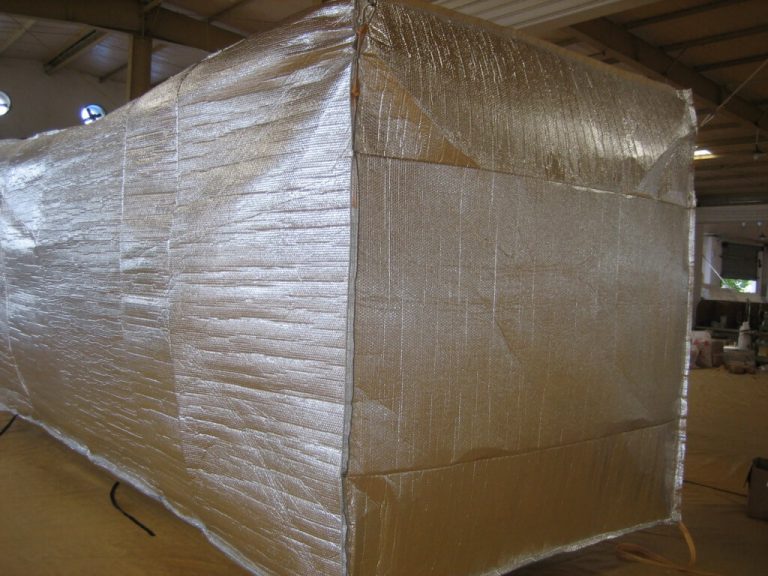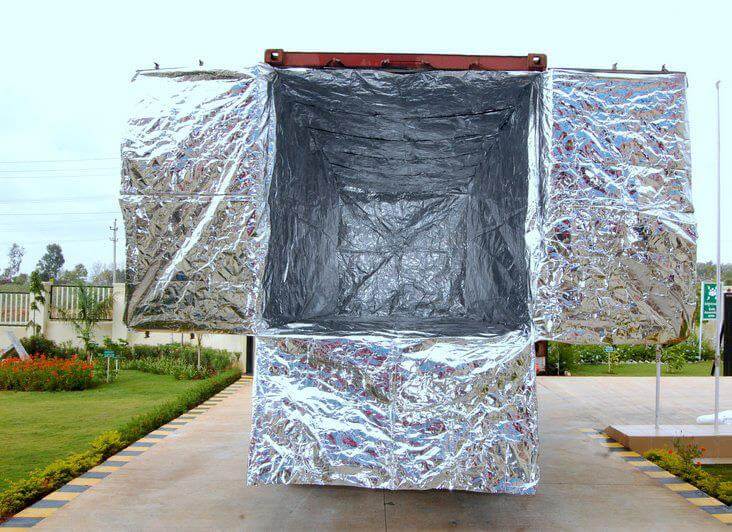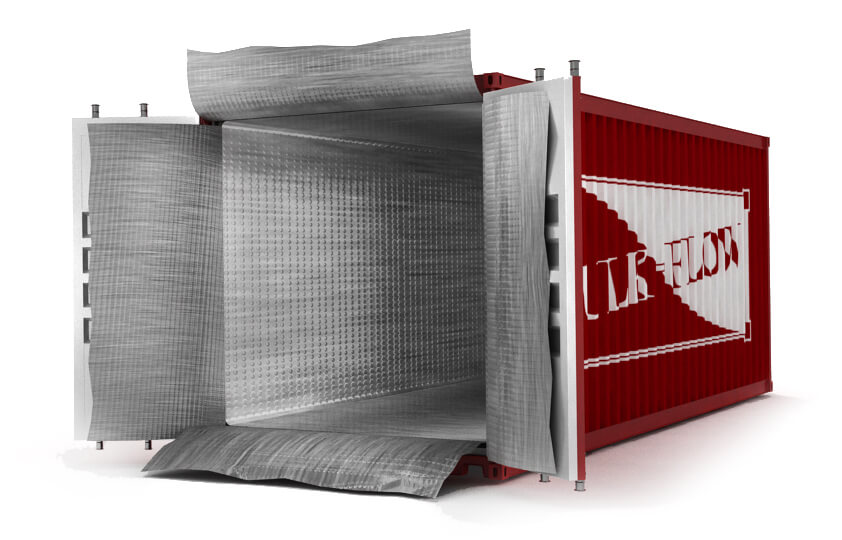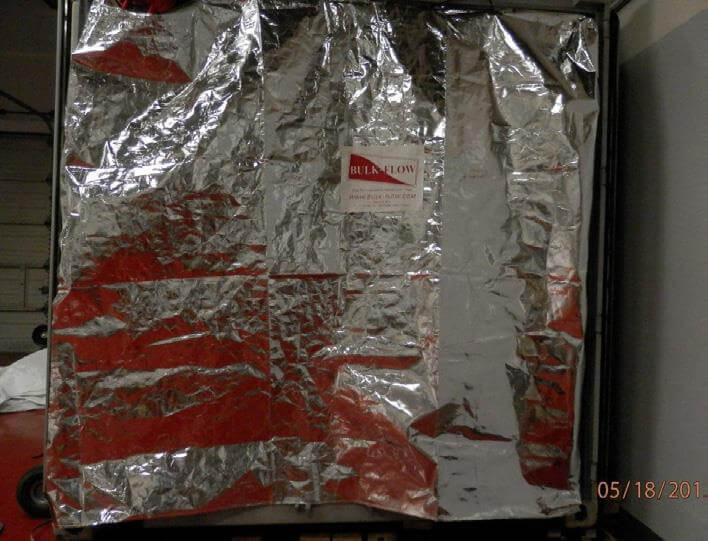The food and beverage industry has some particularities regarding the degradation of the products due to UV radiation, high/low temperatures, high temperatures’ amplitude, moisture, contamination, etc.
Because of those particularities, it is important to have some sort of insulation to avoid most of the agents described above – heat, UV radiation, moisture, etc. – when shipping food and beverage products.

For most liquids, there are two basic modes of transportation using marine containers that depend on how they are packed.
When the product is not already fractioned in bottles, jugs, barrels, multi-gallon containers or cartons destined for final consumption, the liquid products can be transported in flexible tanks fitted inside ISO marine containers (normally 20’ containers). Otherwise, they are transported in bundles or packages on pallets.
Either way, there is still a need for insulation, once on many trips, at least 6 months a year, the containers leave in a low temperature zone and arrive in a high temperature zone, or suffer from lots of temperature changes along the route.
The temperature changes can generate more than one undesirable effect – it can condensate moisture over the products while the products suffer from high temperature gradients.
Some of the fractioned products packaged before transporting, such as dairy, fruit juices, resins, adhesives, solvents, and paints, can have shelf-life dwindle and flavor and textures changed from the exposure to high temperatures or gradients.
Some products like mineral water, soft drinks, fresh fruits, and vegetables can grow algae or have modified flavor and textures because of exposure to higher temperatures.
The best way to provide the insulation, either for partitioned products or for bulk flexible tanks, is using thermal liners. The problem to transport certain types of bulk solids is similar if there are products that can spoil with elevated moisture or condensation, or release dangerous gases.
What are thermal liners?
Thermal liners were developed more recently than the regular container bulk liner bag, so they are a little less.
They are mainly used to insulate bulk solids material inside of ISO marine containers or to insulate materials discretely in bottles, cartons, multi-gallon containers, boxes or crates, to avoid irreversible damages from temperature fluctuations, UV exposure or external contamination.
The thermal liners also decrease the condensation formation inside the container once temperature changes decline, reducing the problems generated by moisture inside a container.
Thermal liners can be partial (only on the walls and roof leaving the floor uncovered) or total (insulating the whole interior of the container), sealed or unsealed.
The complete range of uses and possibilities is still unknown to most people who are introduced to this kind of technology.
The goal of this article is to share more information and knowledge about this technology.
One important thing to understand is that the main goals with thermal liners are to reduce the temperature fluctuation inside a marine container while in transit as well as minimize the moisture permeation inside the loaded goods, at the same time.

The principle:
Thermal liners are made with aluminum foil, sometimes with plastic bubble layers.
Even though the principles / laws that govern heat flow by conduction, convection, or radiation are long known, the use of these principles to maximize a heat barrier while minimizing costs are somewhat recent (40 to 50 years).
Air is actually one of the best thermal conduction-convection insulators that we can find. Once in space, all heat transfer to and from the spaceships is made by radiation. From space research, we gather that the combination of the well-known low thermal conductivity of air with the low emission or radiating power of bright aluminum foil creates the insulation. The power of bright aluminum foil has up to 95% emissivity, reflecting up to 95% of the radiant energy received by the container. It is structured in a usable way that minimizes air convection, while minimizing the radiation’s heat transfer.
The gap between the aluminum foil and the container walls maintain air insulation, while the aluminum foil with high emissivity keeps the external IR radiation (the sun) away from the products. In the meantime, the use of a high emissivity material keeps a steady air pocket that generates a convection insulation. The aluminum foil will also dramatically reduce the heat transfer by radiation making it one of the best structures that can keep the compromise between maximum thermal insulation, efficiency and cost.
This is basically where the use of aluminum foils and with plastic bubbles, combined or not, becomes an efficient means to insulate products inside marine containers.

This kind of liner serves primarily as a heat or humidity barrier. The thermal liners are also good flame retardants, serving safety purposes, too.
For a better understanding of the possible uses of thermal liners, the list below shows some of the most important uses and industries – like the food beverage and other industries:
- The first obvious uses are perishable products, like some kinds of human or animal foods, fresh products, etc. Shipping food in containers is one of the most important uses of this type of container bulk liner bag;
- Some medicines that need a stable temperature are also an important application for this kind of container liner bag;
- On some specific routes that have very high temperature variations, thermal liners help keep wine from spoiling by preventing the alcohol, tannins and other components to degrade. At the same time, prevents cork dryness, stopping a reaction between oxygen and wine, too;
- Heat-sensitive material such as special adhesives, some resins or paints;
- Some volatile (or inflammable) products;
- Highly hygroscopic products;
- Special electronic products that can suffer from temperature changes or elevated moisture contact;
- Prevents the fermentation process in products that are kept above a certain temperature level (cocoa beans are a good example);
- Fruit juices and beverages, in general;
- Dairy products.
BULK-FLOW Solution:
Bulk-Flow offers a range of thermal liners that can cover the entire industry’s needs, being more cost effective than the competition, with higher efficiency to insulate the inside of the container. We offer the thermal liners in many different configurations with some unique solutions, such as the double bubble / aluminum foil liner, which offers heavy protection and better results than our competition.
BULK-FLOW also offers thermal liners with two degrees of protection: the low convection radiant barrier liners and the reflective insulation liners to protect heat-sensitive cargo from extreme heat or extreme cold temperatures.
BULK-FLOW’s low convection radiant barrier thermal liners provide good protection and insulation from -24° C to +40° C (-11 to 104 deg. F).

